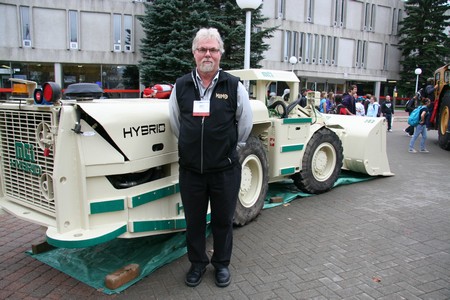 Sudbury-based Mining Technologies International (MTI) has decided to build a four cubic yard hybrid loader, following the successful trial of a smaller 1.5 cubic yard machine at the CANMET experimental mine in Val d'Or, Quebec earlier this year.
Sudbury-based Mining Technologies International (MTI) has decided to build a four cubic yard hybrid loader, following the successful trial of a smaller 1.5 cubic yard machine at the CANMET experimental mine in Val d'Or, Quebec earlier this year.
The smaller hybrid loader is equipped with a metal hydride battery pack and a two cylinder, 35 hp Deutz engine. Testing of the machine at the federal government's CANMET facility concluded in January, following which it was put through its paces at Iamgold's Mouska Mine, an underground gold operation 80 kilometres west of Val d'Or."The machine puts out a lot more torque than we initially anticipated," said Bob Lipic, MTI's president and CEO. "When it gets into the muckpile, it's a real hog. It grabs a full bucket on the first pass, so it's a fast mucking machine and has a lot more power compared to a mechanical drive machine."
The operator at the CANMET mine also gave the hybrid loader high marks for comfort.
"The 1.5 cubic yard machine has a small compartment for the operator and this guy was six foot, four inches (193 centimetres), but he told me it was the most comfortable machine he has operated in 22 years. I was really glad to hear that," said Lipic.
MTI loaders are equipped with a load sensing hydraulics system that eliminates "a lot of the jerky movement you get with a hydrostatic unit," he explained. "If you're sitting on a machine like that underground for seven or eight hours, you feel beat up at the end of a shift, whereas this kind of hydraulics system smoothes out all those jerky movements, making it a lot more comfortable for the operator and easier on the machine."
The 1.5 cubic yard loader did experience several premature failures of the flex coupling, "the transition between the flywheel and the generator," and was brought back to MTI's shop in Sudbury for troubleshooting and repair. The coupling was eventually replaced by a bigger unit that mounts in the same space.
Rave reviews for the machine's power and comfort overlook the primary reason for building the hybrid prototype, which was to reduce diesel emissions underground in anticipation of stricter emission standards planned by the Mine Safety and Health Administration, the U.S. Environmental Protection Agency and CANMET for 2014.
"There's virtually no exhaust compared to a conventional machine," said Randy Wilson, MTI's systems group supervisor. "It's ideal for a mine with very limited ventilation that's handcuffed by how many pieces of diesel equipment it can operate at one time. This loader requires half the ventilation of a conventional unit."
One of the biggest challenges in designing and building the loader was getting the attention of battery suppliers, who are currently deluged by business from the much bigger and more lucrative automobile sector. Metal hydride batteries were selected for the 1.5 cubic yard machine, but MTI is now looking at other battery technologies with a much higher energy density.
The loader runs off the battery. The diesel is there to support and recharge it, eliminating the need to plug in the unit between shifts.
Small, clean-burning diesel engine technology from Europe is ideal for the application, said Lipic, who pointed out that 75 per cent of the cars in Europe are now diesel-powered.
"It normally takes 100 cubic feet per minute of ventilation per horse power operating in an underground environment to dilute the emissions from a diesel engine, and ventilation is very costly for most operations. Here in Canada, some of our bigger mining operations are mature and the orebodies are at depth, so it costs that much more to ventilate and cool the air."
MTI plans to begin building the four cubic yard hybrid in 2011 once the engineering is complete. It, too, will likely be tested at the CANMET mine, but by then, the mining equipment manufacturer will also have its very own underground ramp adjacent to one of its properties in Sudbury.
"We're down to between 100 and 150 feet (30 to 45 metres)," said Lipic. "We're putting a cover over the entrance and putting in electrical and ventilation systems. We may put in two levels so we can set up some stoping situations and demonstrate equipment and techniques to some of our clients."
The looped, underground testing and demonstration facility will also be available to other Sudbury-area underground equipment manufacturers who don't compete with MTI. The ramp system will be excavated to its planned depth and ready for use by the end of March 2011.
www.mti.ca

